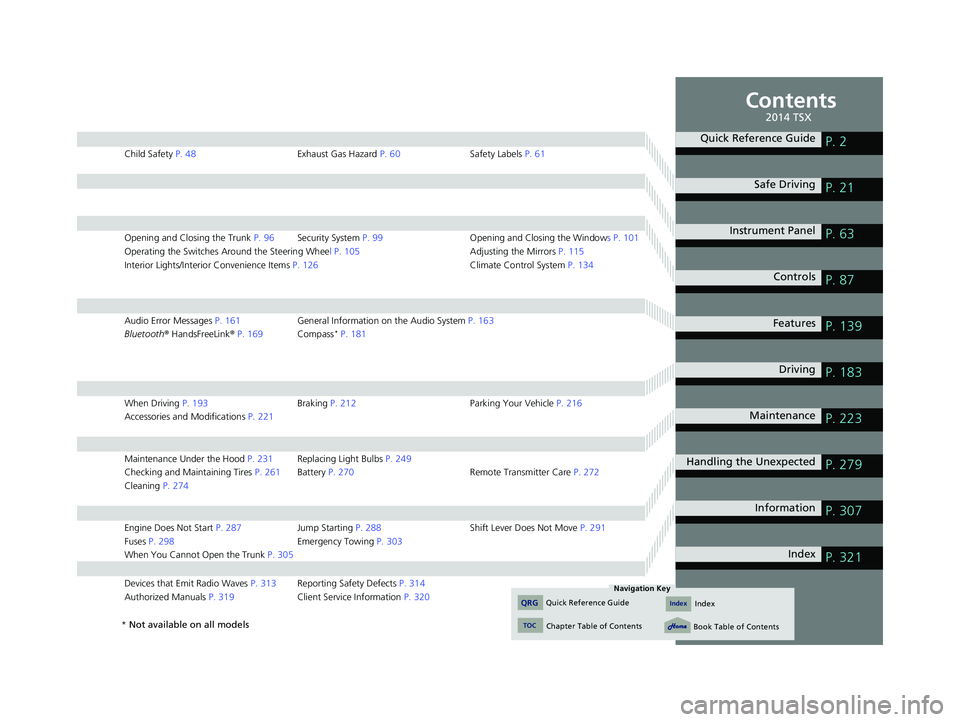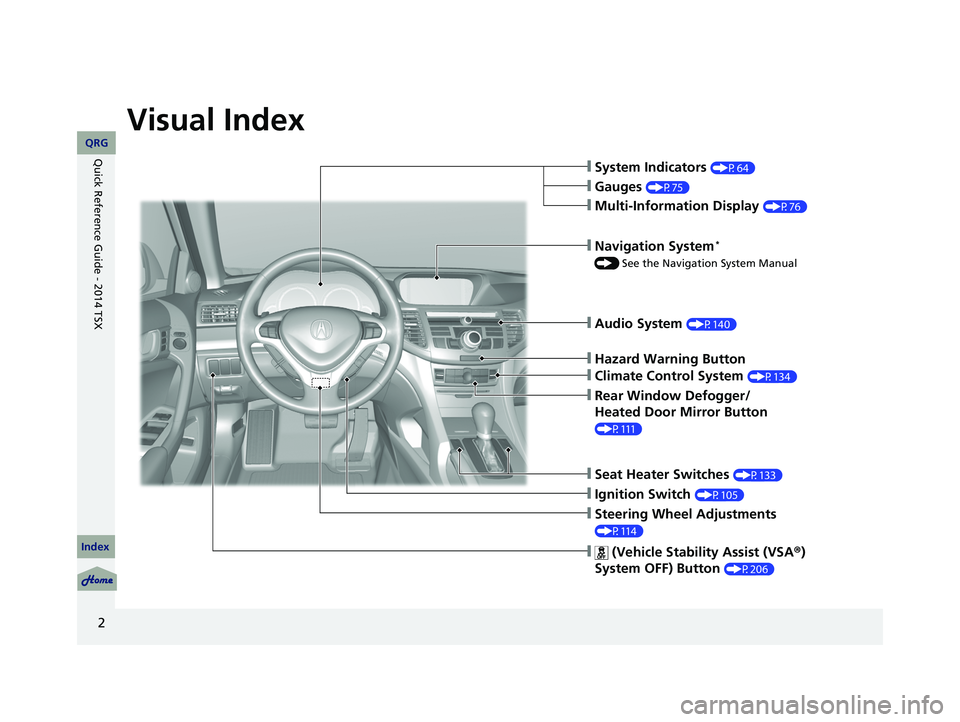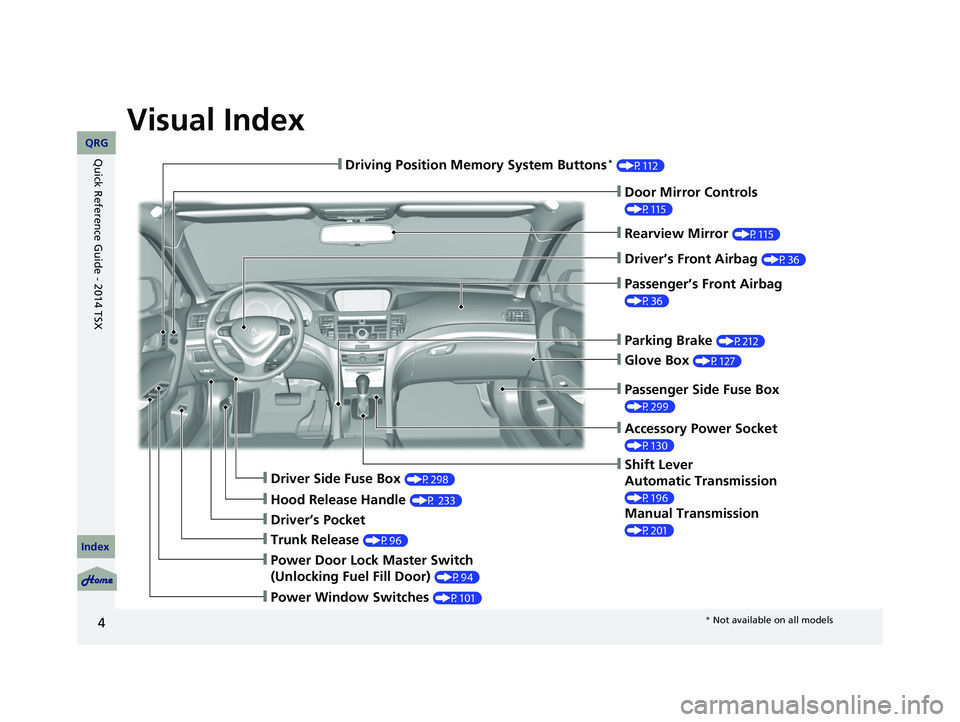window Acura TSX 2014 Owner's Manual
[x] Cancel search | Manufacturer: ACURA, Model Year: 2014, Model line: TSX, Model: Acura TSX 2014Pages: 329, PDF Size: 15.95 MB
Page 2 of 329

Contents
Child Safety P. 48 Exhaust Gas Hazard P. 60 Safety Labels P. 61
Opening and Closing the Trunk P. 96 Security System P. 99 Opening and Closing the Windows P. 101
Operating the Switches Around the Steering Wheel P. 105 Adjusting the Mirrors P. 115
Interior Lights/Interior Convenience Items P. 126 Climate Control System P. 134
Audio Error Messages P. 161 General Information on the Audio System P. 163
Bluetooth® HandsFreeLink ® P. 169 Compass * P. 181
When Driving P. 193 Braking P. 212 Parking Your Vehicle P. 216
Accessories and Modifications P. 221
Maintenance Under the Hood P. 231 Replacing Light Bulbs P. 249
Checking and Maintaining Tires P. 261 Battery P. 270 Remote Transmitter Care P. 272
Cleaning P. 274
Engine Does Not Start P. 287 Jump Starting P. 288 Shift Lever Does Not Move P. 291
Fuses P. 298 Emergency Towing P. 303
When You Cannot Open the Trunk P. 305
Devices that Emit Radio Waves P. 313 Reporting Safety Defects P. 314
Authorized Manuals P. 319 Client Service Information P. 320
Quick Reference GuideP. 2
Safe Driving P. 21
Instrument Panel P. 63
Controls P. 87
Features P. 139
Driving P. 183
Maintenance P. 223
Handling the Unexpected P. 279
Information P. 307
Index P. 321
14 ACURA TSX 4D-31TL16500.book 1 ページ 2013年6月17日 月曜日 午前9時40分
Quick Reference GuideIndex
TOC
Chapter Table of Contents
Navigation Key
QRGIndex
Book Table of Contents
2014 TSX
* Not available on all models
Page 3 of 329

2
Quick Reference Guide - 2014 TSX
Quick Reference Guide
Visual Index
❙System Indicators (P64)
❙Gauges (P75)
❙Navigation System *
() See the Navigation System Manual
❙Audio System (P140)
❙Hazard Warning Button
❙Climate Control System (P134)
❙Rear Window Defogger/
Heated Door Mirror Button
(P111)
❙Seat Heater Switches (P133)
❙Steering Wheel Adjustments
(P114)
❙Multi-Information Display (P76)
❙ (Vehicle Stability Assist (VSA® )
System OFF) Button
(P206)
❙Ignition Switch (P105)
14 ACURA TSX 4D-31TL16500.book 2 ページ 2013年6月17日 月曜日 午前9時40分
QRG
Index
Page 5 of 329

Visual Index
4
❙Door Mirror Controls
(P115)
❙Parking Brake (P212)
❙Glove Box (P127)
❙Rearview Mirror (P115)
❙Shift Lever
Automatic Transmission
(P196)
Manual Transmission
(P201)
❙Driver Side Fuse Box (P298)
❙Passenger Side Fuse Box
(P299)
❙Driver’s Pocket
❙Trunk Release (P96)
❙Power Window Switches (P101)
❙Driving Position Memory System Buttons * (P112)
❙Driver’s Front Airbag (P36)
❙Hood Release Handle (P 233)
❙Passenger’s Front Airbag
(P36)
❙Accessory Power Socket
(P130)
❙Power Door Lock Master Switch
(Unlocking Fuel Fill Door)
(P94)
14 ACURA TSX 4D-31TL16500.book 4 ページ 2013年6月17日 月曜日 午前9時40分
QRG
Index
Quick Reference Guide - 2014 TSX
* Not available on all models
Page 11 of 329

10
Unlocking the Front
Doors from the Inside
(P93)
●Pull either front door inner handle to
unlock and open it at the same time.
Trunk (P 96)
● To open the trunk:
Press the trunk release.
Press the trunk release button on the
remote transmitter.
With all the doors unlocked, press the
trunk release button on the trunk lid.
Trunk Release
Power Door Mirrors
(P115)
●
With the ignition switch in ON
(
w
, move
the selector switch to L or R .
● Push the appropriate edge of the
adjustment switch to adjust the mirror.
● Place the selector switch in the R position
to use the reverse tilt door mirror feature.
Selector Switch
Adjustment Switch
Power Windows (P 101)
● With the ignition switch in ON
(
w
, open
and close the power windows.
● If the power window lock button is in the
off position, each passenger’s window
can be opened and closed with its own
switch.
● If the power window lock button is in the
on position (indicator on), each
passenger’s window switch is disabled.
Power Window
Lock Button
Window Switch Indicator
14 ACURA TSX 4D-31TL16500.book 10 ページ 2013年6月17日 月曜日 午前9時40分
QRG
Index
Quick Reference Guide - 2014 TSX
Page 12 of 329

11
Climate Control System (P134)
● Press the AUTO button to activate th e climate control system.
● Press the ON/OFF button to turn the system on or off.
● Press the button to defrost the windshield.
The climate control system is voice operabl e. See the Navigation System Manual for
complete details.
Models with navigation system
(Rear Window Defogger/
Heated Mirror) Button
(Windshield Defroster) Button
A/C (Air Conditioning)
Button
Air flows from dashboard
vents and back of the
center console
*.
Air flows from floor and
dashboard vents, and back
of the center console
*.
Air flows from floor vents. Air flows from floor and
windshield defroster vents.
(Recirculation) Button
(Fan Control) Bar
Passenger’s Side
Temperature
Control Switch
SYNC
(Synchronized) Button
AUTO Button
Driver’s Side
Temperature
Control Switch
ON/OFF Button MODE Control Button
Clock (P88)
aPress the CLOCK button until the
displayed time begins flashing.
bPress Preset (
4
(Hour) or (
5
(Minute)
to set the time. Press Preset
(
6
(Reset)
to set the time to the nearest hour.
cPress the CLOCK button again to set
the time.
The navigation system receives signals from
GPS satellites, updating the clock
automatically.
Models without navigation system
Models with navigation system
* Not available on all models
14 ACURA TSX 4D-31TL16500.book 11 ページ 2013年6月17日 月曜日 午前9時40分
QRG
Index
Quick Reference Guide - 2014 TSX
Page 35 of 329

34
uu Airbags u Airbag System Components
The front, front side, and side curtain
airbags are deployed according to the
direction and severity of impact. The
airbag system includes:
aTwo SRS (Supplemental Restraint
System) front airbags. The driver’s airbag
is stored in the center of the steering
wheel; the front passenger’s airbag is
stored in the dashboard. Both are
marked SRS
AIRBAG .
bTwo side airbags, one for the driver and
one for a front passenger. The airbags are
stored in the outer edges of the seat-
backs. Both are marked SIDE AIRBAG.
cTwo side curtain airbags, one for each
side of the vehicle. The airbags are stored
in the ceiling, above the side windows.
The front and rear pillars are marked
SIDE CURTAIN AIRBAG .
dAn electronic control unit that continually
monitors and records information about
the sensors, the airb ag activators, the
seat belt tensioners, and driver and front
passenger seat belt use when the ignition
switch is in ON
(w
.
eAutomatic front seat belt tensioners. The
driver’s and front passenger’s seat belts
incorporate sensors that detect whether
or not they are fastened.
fA driver’s seat position sensor. If the seat
is too far forward, the airbag will inflate
with less force.
gWeight sensors in the front passenger’s
seat. The front passenger’s airbag will be
turned off if the weight on the seat is 65
lbs (29 kg) or less (the weight of an infant
or small child).
hImpact sensors that can detect
a moderate-to-severe front or
side collision.
iAn indicator on the dashboard that alerts
you that the front passenger’s front
airbag has been turned off.
jSensors that can detect if a child or small
statured adult is in the deployment path
of the front passenger’s side airbag.
kAn indicator on the instrument panel that
alerts you to a possible problem with your
airbag system or seat belt tensioners.
lAn indicator on the instrument panel that
alerts you that the fr ont passenger’s side
airbag has been turned off.
mSafing Sensor
14 ACURA TSX 4D-31TL16500.book 34 ページ 2013年6月17日 月曜日 午前9時40分
QRG
Index
Safe DrivingTOC
Page 37 of 329

36
uu Airbags u Types of Airbags
Types of Airbags
Your vehicle is equipped with three types of airbags:
• Front airbags: Airbags in front of the driver ’s and front passenger’s seats.
• Side airbags: Airbags in the driver’s and front passenger’s seat-backs.
• Side curtain airbags: Airbags above the side windows.
Each is discussed in the following pages.
Front Airbags (SRS)
The front SRS airbags inflate in a moderate-to -severe frontal collision to help protect
the head and chest of the driver and/or front passenger.
SRS (Supplemental Restraint System) indicates that the airbags are designed to
supplement seat belts, not replace them. Seat belts are the occupant’s primary
restraint system.
The front airbags are housed in the center of the steering wheel for the driver, and
in the dashboard for the front pass enger. Both airbags are marked SRS AIRBAG.
■Housing Locations
1Types of Airbags
The airbags can inflate whenever the ignition switch
is in ON
(
w
.
After an airbag inflates in a crash, you may see a
small amount of smoke. This is from the combustion
process of the infl ator material and is not harmful.
People with respiratory pr oblems may experience
some temporary discomfort. If this occurs, get out of
the vehicle as soon as it is safe to do so.
1 Front Airbags (SRS)
Dual-Stage, Multiple-Threshold Front Airbags
(SRS)
Your vehicle is equipped wi th dual-stage, multiple-
threshold front airbags (SRS).
During a frontal crash severe enough to cause one or
both front airbags to deploy, the airbags can inflate
at different rates, dependi ng on the severity of the
crash, whether or not the se at belts are latched, and/
or other factors. Frontal airbags are designed to
supplement the seat belts to help reduce the
likelihood of head and chest injuries in frontal
crashes.
14 ACURA TSX 4D-31TL16500.book 36 ページ 2013年6月17日 月曜日 午前9時40分
QRG
Index
Safe DrivingTOC
Page 44 of 329

43
uu Airbags u Side Curtain Airbags
Side Curtain Airbags
The side curtain airbags help protect the h eads of the driver and passengers in outer
seating positions during a moderate-to-severe side impact.
The side curtain airbags are located in the
ceiling above the side windows on both sides
of the vehicle.
The side curtain airbag is designed to deploy
in a moderate-to-severe side impact.
■When side curtain airbags deploy in a frontal collision
One or both side curtain airbags may inflate in a moderate-to-severe angled
frontal collision.
In this case, the side curtain airbags will deploy slightly after the front airbags.
■Housing Locations
1 Side Curtain Airbags
The side curtain airbags are most effective when an
occupant is wearing thei r seat belt properly and
sitting upright, well back in their seat.
Do not attach any objects to the side windows or roof
pillars as they can interfere with the proper operation
of the side curtain airbags.
Side Curtain Airbag Storage
■Operation
Deployed Side Curtain Airbag
14 ACURA TSX 4D-31TL16500.book 43 ページ 2013年6月17日 月曜日 午前9時40分
QRG
Index
Safe DrivingTOC
Page 50 of 329

49
uu Child Safety u Protecting Child Passengers
• Any child who is too small to wear a seat belt correctly must be restrained in an
approved child seat that is properly secured to the vehicle using either the lap belt
portion of the lap/shoulder belt or the lower anchors of the LATCH system.
•Never hold a child on your lap because it is impossible to protect them in the
event of a collision.
• Never put a seat belt over yourself and a child. During a crash, the belt would
likely press deep into the child and cause serious or fatal injuries.
• Never let two children use the same seat belt. Both children could be very
seriously injured in a crash.
• Do not allow children to operate the doors, windows or seat adjustments.
• Do not leave children in the vehicle unatte nded, especially in hot weather when
the inside of the vehicle can get hot enough to kill them. They could also activate
vehicle controls causing it to move unexpectedly.
1 Protecting Child Passengers
To deactivate a lockable retractor, release the buckle
and allow the seat belt to wind up all the way.
To remind you of the pa ssenger’s front airbag
hazards and child safety, your vehicle has warning
labels on the dashboard (U.S. models) and on the
front visors. Please read and follow the instructions
on these labels. 2 Safety Labels P. 61
3 WARNING
Allowing a child to play with a seat belt or
wrap one around their neck can result in
serious injury or death.
Instruct children not to play with any seat
belt and make sure any unused seat belt a
child can reach is buckled, fully retracted,
and locked.
14 ACURA TSX 4D-31TL16500.book 49 ページ 2013年6月17日 月曜日 午前9時40分
QRG
Index
Safe DrivingTOC
Page 61 of 329

60
Exhaust Gas Hazard
Carbon Monoxide Gas
The engine exhaust from this vehicle contains carbon monoxide, a colorless,
odorless, and highly toxic gas. As long as you properly maintain your vehicle, carbon
monoxide gas will not get into the interior.
■Have the exhaust system in spected for leaks whenever
• The exhaust system is m aking an unusual noise.
• The exhaust system may have been damaged.
• The vehicle is raised for an oil change.
When you operate a vehicle with the trunk open, airflow can pull exhaust gas into
the interior and create a hazardous condition. If you must drive with the trunk open,
open all the windows and set the climate control system as shown below.
1. Select the fresh air mode.
2. Select the mode.
3. Set the fan speed to high.
4. Set the temperature control to a comfortable setting.
Adjust the climate control system in the same manner if you sit in your parked
vehicle with the engine running.
1 Carbon Monoxide Gas
An enclosed area such as a garage can quickly fill up
with carbon monoxide gas.
Do not run the engine with the garage door closed.
Even when the garage door is open, drive out of the
garage immediately afte r starting the engine.
3 WARNING
Carbon monoxide gas is toxic.
Breathing it can cause unconsciousness and
even kill you.
Avoid any enclosed areas or activities that
expose you to carbon monoxide.
14 ACURA TSX 4D-31TL16500.book 60 ページ 2013年6月17日 月曜日 午前9時40分
QRG
Index
Safe DrivingTOC